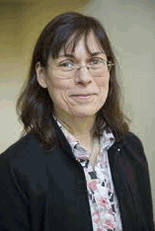|
|
|
|
|
|
|
News & Views item - July 2013 |
![]() WebGURU and the Research Experience for Undergraduates. (July 7, 2013)
WebGURU and the Research Experience for Undergraduates. (July 7, 2013)
The American Association for the Advancement of Science's AAAS MemberCentral recently interviewed Professor of Chemistry Patricia Ann Mabrouk, the Founder of WebGURU,at Northeastern University "to learn more about the resource and how to set up positive research experiences for undergraduates".
AAAS MemberCentral: Can you explain the purpose of
WebGURU? What led to the creation of this resource?
Patricia Ann Mabrouk, PhD: WebGURU was designed to be a resource for students around the world interested in getting involved in undergraduate research. I have believed passionately in the transforming power of undergraduate research since I myself became involved in undergraduate research as a freshman at Wellesley College. The project started when I realized that students wanted (1) a web-based resource that they could turn to on undergraduate research; and (2) information on what undergraduate research opportunities are available.
AAAS MemberCentral: How does
WebGURU help prepare undergraduates for a research experience?
Mabrouk: WebGURU is a one-stop shop for
students interested in undergraduate research. It provides information on who,
what, when, where, and why for undergraduate research. Students can find information on how to find a
faculty member or Research Experience for Undergraduates (REU) program, info on
how to start a project, how to fund a project, conferences, publications, and
even on grad school. The information on the site is informed by students.
why for undergraduate research. Students can find information on how to find a
faculty member or Research Experience for Undergraduates (REU) program, info on
how to start a project, how to fund a project, conferences, publications, and
even on grad school. The information on the site is informed by students.
AAAS MemberCentral: What do you think are the most
common issues or problems that undergraduates face when starting research for
the first time?
Mabrouk:
Finding the right mentor. Many students go into their selection of a research mentor blind and don’t make wise choices. Making a good decision starts with knowing who you are – what you want and what kind of an environment you need in order to learn and grow. It also requires that you approach finding a mentor the same way you would when seeking employment: is this person someone for whom you would like to work? If the answer is no, then cast your net more widely.
Facing failure. Research is fundamentally built on the idea of trying and failing. Somehow our formal educational system has refined and distilled classroom laboratory experiences for younger students into two to three hour-long enactments of steps in scientific investigations in which students are provided with no opportunity to fail or to experiment. Real research takes time – often years of investigation in order to yield tangible results worth communicating to the greater community of practice. Real research involves making mistakes. This is how we learn and how science moves forward.
Understanding the research process and what research really is. Most students see research through the lens of their high school and college classrooms, where instruction is often lecture-driven with an emphasis on the transmission of content knowledge from the instructor to the student, and college/university laboratories, which frequently use canned experiments in which students are provided with a carefully outlined method and for which the desired outcomes are already known both to the instructor as well as the savvy student. These experiences are misleading and do not reflect the genuine research process which is inherently creative and collaborative.
AAAS MemberCentral: What can
professors, postdocs, and grad students do to help undergraduates transition
into a research environment?
Mabrouk: I am a big believer in well-crafted, thoughtfully designed undergraduate research experiences. I usually invite a new student into my lab and give him/her a project on which we are already working and where we have already made some headway. This allows me to ensure that the student has a good project. I define a good project as something potentially doable that will potentially result in real scholarship. I also make sure that the student has at least one other student he/she can turn to for information and assistance in the lab in addition to myself. Once the student gets his/her feet wet on the first project, I sit down and discuss with the student whether they wish to continue with this project or whether there is another project in the lab that they would like to work on. This ensures that my students have a sense of ownership of their science and that their projects allow them to explore fields/topics that are of interest to them in their career development. When students select their own project we craft a research proposal for the project. This allows me to teach them how to “fish.”
A somewhat artificial vehicle I use to structure student experiences is a research-learning contract (RLC). This is really a covenant between me as the faculty mentor and my student that allows the student to outline their understanding of the goal of the project and the steps we will take in order to achieve our goal. The RLC allows my students to identify what they want out of their experience in terms of skills, professional development opportunities (such as conference participation, etc), as well as the metrics we will use for assessment at the end of their experience. I believe using an RLC minimizes misunderstandings concerning what the project will look like and how success will be measured/demonstrated.
AAAS MemberCentral:
What is your favorite part of the WebGURU site?
Mabrouk: The whole site really because the site itself is the result of an interdisciplinary undergraduate student/graduate student research project.